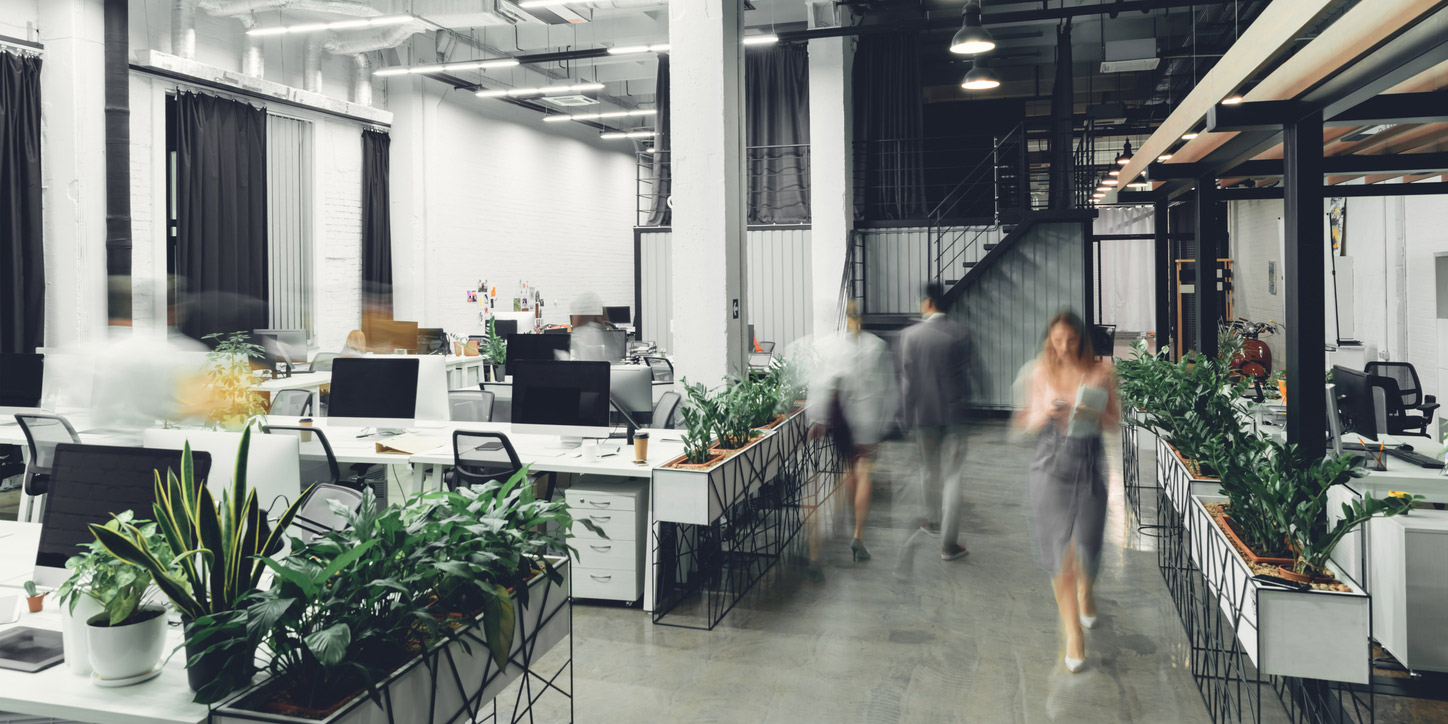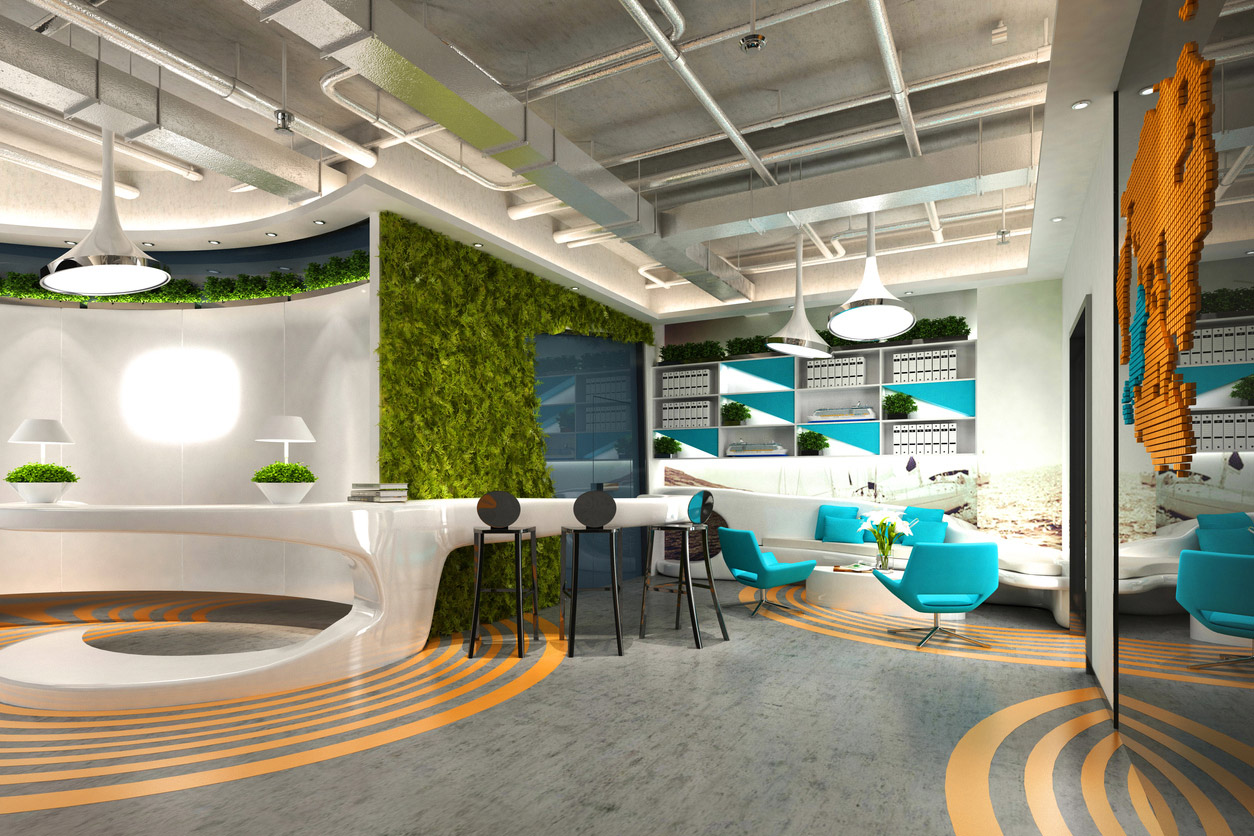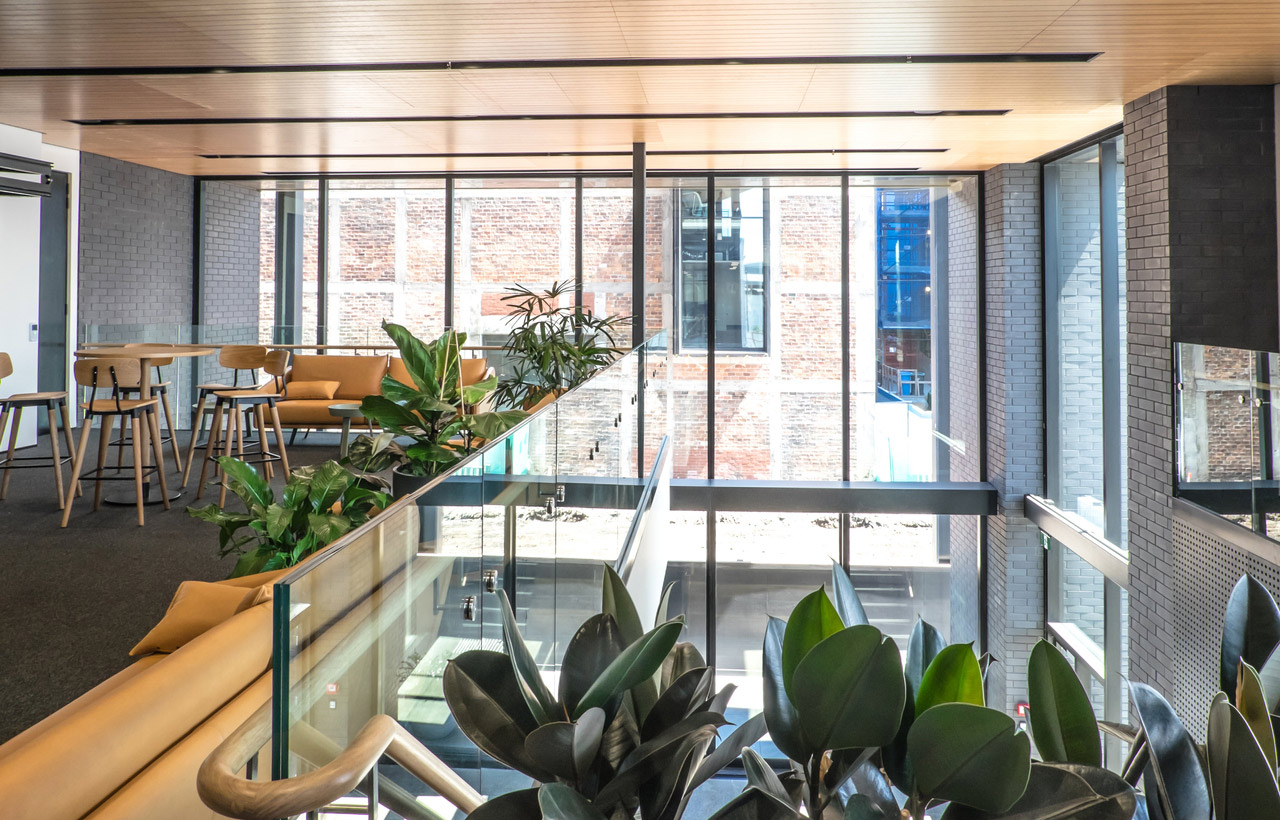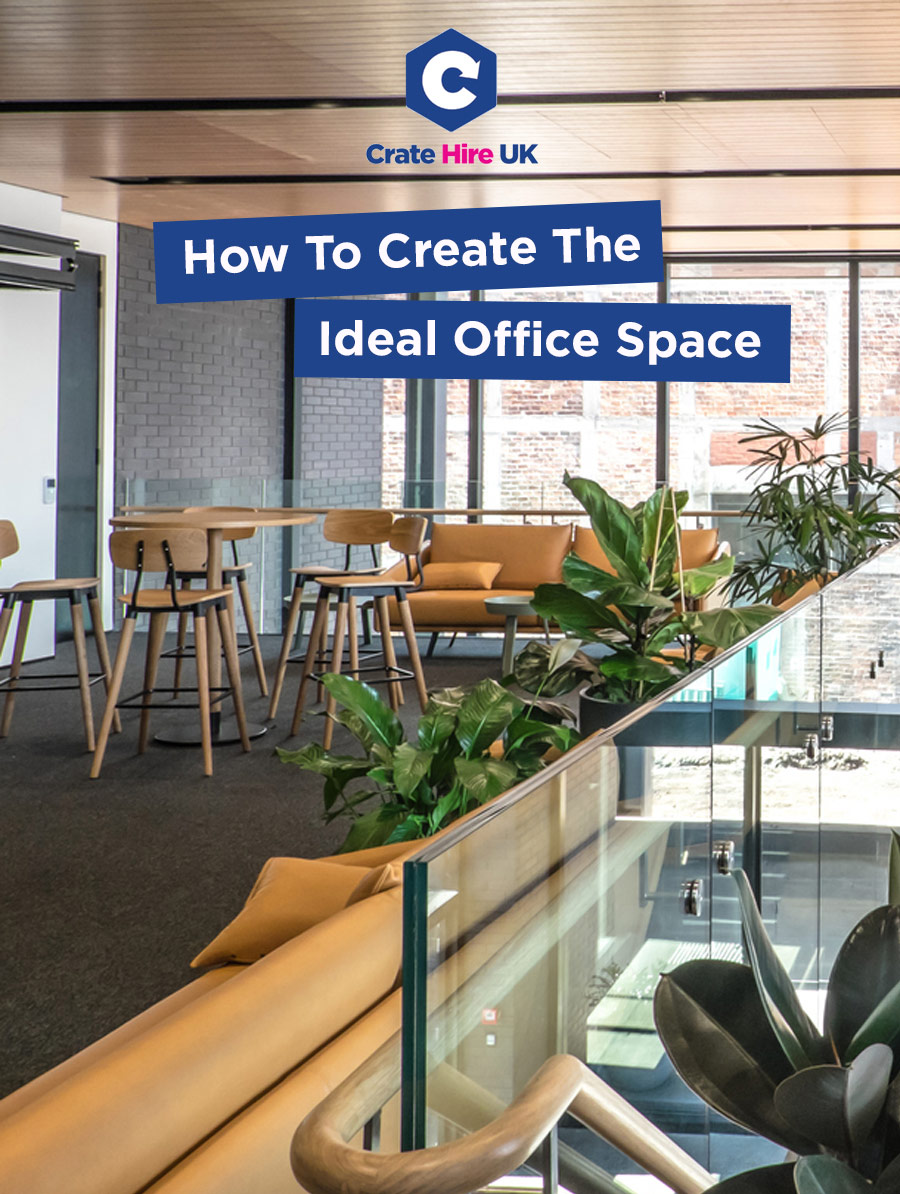If you’re relocating and wondering how you can make your new office a happy, productive and greener space, you’ve come to the right place. This article is packed full of tips and advice on how to create the ideal office space that encourages wellness, creativity and crucially, productivity!

Guide Contents
- The impact that moving office can have on employees
- Some of the things you’ll need to consider and do ahead of moving office
- Putting employee wellbeing first
- Making your office space greener
- Carbon offsetting
- Key Takeaway Tips for Creating the Ideal Office Space
Whilst moving office can be a mammoth undertaking requiring many months of planning, once the logistical challenges of your move have been dealt with, it’s time to turn your attention to planning the new office space.
Whilst open-plan offices remain the top choice for most businesses, a recent article looked at the dark side of hip office design. The article stated that modern workspaces often look great, but are often too noisy and busy, leading to greater levels of distraction and stress.
Sir Stuart Lipton likens modern open plan offices to battery chicken farms stating that “factory farming is when design is driven by cost and companies don’t think about the engagement of their employees.”
It’s important then to not just think about the aesthetic appeal of your office but on how that design will affect your employees. Larger businesses are likely to consult with a specialist office design company, but for smaller businesses and when it comes to decision-making time when you’re presented with options from your office interior designers or fitters, it pays to know what elements combine to result in the ideal office space.
In this article we’ll talk a fair bit about wellbeing, which has become a bit of a buzzword over the last few years, but what do we really mean by wellbeing?
Many people believe that wellbeing ultimately means happiness, but it’s more complicated than that. Evidence suggests that there are 5 vital components of wellbeing in broad terms;
- Connecting with other people
- Being physically active
- Learning new skills
- Giving to others
- Being focused on the here and now (mindfulness)
One of the biggest issues with modern offices is that employees are confined to desks, typically for many hours at a time, in some cases punctuated only by standing to make a cup of tea or go to the bathroom. This forced inactivity is not only bad for our health, but it can make joint conditions like Arthritis worse, it can exacerbate back pain and of course, it means all that sedentary time can have a devastating long-term impact on health.

In comparison, consider the scenario when you work from home. One of the best things about working from home is that you can get up and move around whenever you feel like it. Feel like you need a short burst of activity or a 5-minute break to help improve your focus or stimulate creativity? Simple, walk into the kitchen and do the washing up or wander outside and admire your garden – you get a break from work and a bit of physical activity in at the same time, and even with frequent breaks like this throughout the day, employees working from home can often end up being far more productive than when they are in the office.
Providing breakout areas or different spaces for your employees to use, encouraging frequent breaks and incorporating walking meetings can all go at least some way to combatting inactivity and improving employee wellbeing.
The impact that moving office can have on employees
Moving office is a massive undertaking, even for small businesses, but the most critical consideration is to ensure any disruption to your business is minimised, allowing you get on with business as usual as quickly as possible.
The move can feel like a major upheaval for some employees especially those that might have an anxiety condition where concerns about the unknown can exacerbate problems. Worrying about whether there will be enough parking, proximity to amenities and so on can all be a source of worry. Ensure your staff are well informed about the move, give them as much detailed information as possible about the new location and take time to reassure them. Calling a meeting to discuss the move ahead of time can be a great way to let your employees known more and ask questions.
Some of the things you’ll need to consider and do ahead of moving office
- Let all of your clients know about your move and provide them with details of your new address, announce the move on your company website, send every client out an email to let them know about the move and reassure them by providing details on how they can contact you during and immediately after the move.
- Let your staff know about the new building and the location so they’ll have a clear idea of what they can expect in terms of facilities and local amenities.
- Try to time your move to coincide with when your current lease is up to help minimise the chance of incurring any penalties, if you will incur penalties, you need to factor this cost in.
- Ensure any business services you use are cancelled or where possible transferred to your new location.
- Let all of your clients know about your move and provide them with details of your new address, announce the move on your company website, send every client out an email to let them know about the move and reassure them by providing details on how they can contact you during and immediately after the move.
- Realistically plan for down-time and work out what the financial impact on your business will be. It might take a day or two to get up and running at your new location so ensure you make a realistic estimate about how long it will take before it’s business as usual again.
- Update your website and all of your online listings, for example business listings in directories like Yell and Scoot as well as your Google My Business listing and so on.
- Update all printed materials for example company brochures, price lists and employee business cards with the new address and contact numbers if you aren’t able to transfer your existing phone number.
- Book services like telephone and broadband installation or connections well in advance to ensure you’ll be connected before or on the day of your move.
- Consider specialist business equipment and leased office assets such as printers, vending machines and so on. These may require specialist handling to move.
- Think about what service contracts you have and ensure all of your providers are aware of your new address so they can update their records.
- Decide what to do with old or unwanted furniture well ahead of your move. Now is a great time to get rid of old equipment and furniture (this will save on moving costs) but do make sure you dispose of any items responsibly.
- Ensure you’ve planned what fixtures and fittings you’ll need to invest in for your new office location, from office furniture to signage and décor. If you’re using a professional office design and fitting company ensure that you’ve booked their services well in advance.
- Think about how you’ll store the contents of your office whilst you pack up ready for your move, even if you’re using a professional relocation company, you may still need to pack away and store some of the contents of your office in which case you may need to hire crates several weeks before your moving date.
Putting employee wellbeing first
Whether you’re using a specialist office design and fitting company or you’re planning to do it yourself, keeping the wellbeing of your employees at the forefront of your mind is vitally important.

Whilst wellbeing is a bit of a buzz word at the moment, there’s a lot of firm scientific evidence that supports the fact that wellbeing is a crucial component of productivity. Happy employees tend to be more productive and if they are recognised and supported in their roles, they are more likely to want to stay, making it more likely they’ll stick around, helping you to retain the talent you have.
Remember too that when it comes to employee wellbeing, even very small changes can have a bit impact.
1. Minimise workplace distractions
Distractions include anything that might disrupt workflow, from meetings and phone calls to social media and answering a never-ending stream of emails. Having policies in place that will help to minimise disruptions, but still provide a good degree of autonomy and freedom is the best way of helping your employees to be more productive.
2. Healthy workplace culture
In some sectors a culture of staying late and over-working is prevalent. Sometimes going above and beyond is necessary, but this should be the exception and not the norm.
The results of research from 2016 revealed that 40% of the British workforce didn’t make use of their full holiday entitlement and 1 in 6 employees admitted to having more than a whole working week of unused leave spare that year.
Creating a culture where hard work is celebrated and recognised is no bad thing, but employees who are routinely overworking, not taking their full leave entitlement or expected to stay late are more likely to burn out which can lead to time off for stress-related illnesses and contribute to a higher level of employee turnover.
3. Consider conditions inside the office
Consider the basics like lighting and temperature. Ensure the temperature inside the office is around 20 to 21 degrees. Even small fluctuations in temperature can provide at best, a distraction, but at worst working in an environment that’s hot and stuffy or very cold can be downright unpleasant.
Make sure any centrally controlled heating or air conditioning is adjusted not only to suit the season, but for the weather conditions on any particular day, and make sure you have fans and portable heaters on hand to cool or warm the office quickly if necessary.
As well as temperature, lighting is also important, too dark it can lead to poorer concentration and lethargy, similarly too bright and it can strain the eyes of employees.
4. Desk and chair comfort
With most office workers having to remain seated for long periods of time and with back complaints increasingly common, ensuring office furniture is ergonomic is important. Decent office chairs are one area you should never scrimp on and will help to keep employees comfortable throughout the working day.
Likewise, your choice of desk is also important, they should be big enough to ensure there is enough space for all the essentials and choosing height-adjustable desks makes sense too, allowing employees to adjust for their comfort. You’ll find tips on how to choose the right office desks here and If you’re looking for ideas for your new office space, you can find some inspiring office interior ideas here.
Making your office space greener
A huge amount of research has been conducted during the last decade about the impact that green spaces have on mental health. Turns out that green spaces really are good for us, providing a variety of benefits, from reducing stress levels to helping to remedy mild cases of depression.
Of course, unless you have a very large office building set within its own grounds, or you’re located in a building that is lucky enough to have a quad or atrium, then an office could never truly be regarded as a green space, but there are elements of ecotherapy that can be incorporated into your office design to help boost the wellbeing of your employees.

Research cited by K2 Space claims that when natural elements like sunlight and greenery are introduced into an office environment, employees report a 15% higher level of wellbeing, a 15% increase in creativity and 6% greater productivity.
Take a look at our blog post featuring 10 tips for a happy and healthy office.
As well as thinking about making your office space physically greener by introducing plants and similar elements, also think about how you can reduce your carbon footprint as a business.
GDPR dictates that all papers and documents should be disposed of in a secure manner to ensure that no data breaches occur, so when it comes to document shredding, the method you use to do this can help you towards reducing your carbon footprint. Look for a professional paper shredding service that not only provides a secure, GDPR compliant service but one that also recycles all of the shredded paper that they collect from you.
Before considering working with any new suppliers, take into account the environmental impact of the service being provided and opt for companies who offset the environmental impact as much as possible.
Carbon offsetting
Global warming is increasingly talked about on the news and there is a plethora of irrefutable evidence revealing the true impact of the damage being done to the planet. Better awareness of the damage we’re doing to the environment has lead more and more businesses to do something about their impact on the planet by introducing carbon offsetting initiatives.
For most service industries with office-based workers, the biggest impact on the environment is likely to be a result of employee travel. Outside of major cities, most employees will make the commute to work by car, so offsetting employee travel at the very least should be a goal for most businesses.
For flights, you can opt to pay a small additional fee at the time of booking to offset journeys, but for daily commutes by car or for staff working out in the field or driving to meetings, you may want to consider using the services of a specialist carbon offsetting company that will do things like plant trees to offset carbon emissions on your behalf.
A very practical way to help decrease the carbon footprint of your business is to conduct as much business digitally as possible, favouring meetings by Skype for example rather than face to face. This isn’t always possible for every business though and for some businesses, there’s a clear need for face to face meetings, which is where keeping track of travel and subsequent emissions becomes more important.
You can purchase ‘credits’ equivalent to carbon emissions and these credits are then invested into carbon offsetting Initiatives that actively reduce greenhouse gasses.
You can find out more about carbon offsetting here.
Key Takeaway Tips for Creating the Ideal Office Space
- Don’t try to squeeze too many people into a space – cramped working conditions can increase stress and ultimately lead to lower levels of productivity.
- Think green and bring a touch of the outside in by incorporating plants into the office or even living walls. This will not only help improve the air quality of the office, but they can have a beneficial effect on the wellbeing of employees.
- Try to avoid hot-desking where possible as this has been proven to increase stress in employees.
- Think smart and creatively to make the most of the space you’ve got, if you’re needing to downsize and are moving to a smaller office, take a look at our guide on maximising a small office workspace.
- Think about where teams are placed and ensure teams that need to liaise frequently with each other are placed in closer proximity to teams who don’t work directly together.
- Consider carbon offsetting initiatives that will help to offset the environmental impact of your business, from how you recycle office paperwork to offsetting the carbon emissions of your commuting employees.
- Keep your office at the optimum temperature whatever the weather and ensure the temperature is comfortable to work in.
- Create a number of different spaces for employees to use, including an area with soft furnishing (these also help to absorb noise). Breakout areas are a useful addition to your office space as they give employees somewhere to retreat to should they need a time out and they also make a great spot for informal meetings.
- Lighting is important, of course it needs to be bright enough to ensure alertness, but harsh strip lights can have a detrimental effect as employees with sensitive eyes will find their eyes tire quickly when subjected to harsh lighting all day. Natural light should always be a preference as exposure to light impacts mood, with a direct impact on wellbeing and productivity.
- Colour is a powerful tool and research has shown countless times that colour can have a big impact on mood, energy levels and even productivity.
- Create a culture where hard work is recognised and rewarded, but don’t let over-working become the norm. Encourage employees to use up their leave entitlement and ensure you processes in place to help you spot employees who are routinely over-working and take steps to mitigate any negative impact on their wellbeing that this might cause.



